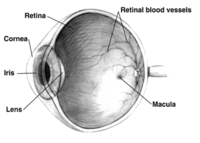
Photo from wikipedia
Advancement of imaging technology in retinal diseases provides us more precise understanding and new insights into the diseases’ pathologies. Diabetic retinopathy (DR) is one of the leading causes of sight-threatening… Click to show full abstract
Advancement of imaging technology in retinal diseases provides us more precise understanding and new insights into the diseases’ pathologies. Diabetic retinopathy (DR) is one of the leading causes of sight-threatening retinal diseases worldwide. Colour fundus photography and fluorescein angiography have long been golden standard methods in detecting retinal vascular pathology in this disease. One of the major advancements is macular observation given by optical coherence tomography (OCT). OCT dramatically improves the diagnostic quality in macular edema in DR. The technology of OCT is also applied to angiography (OCT angiograph: OCTA), which enables retinal vascular imaging without venous dye injection. Similar to OCTA, in terms of their low invasiveness, single blue color SLO image could be an alternative method in detecting non-perfused areas. Conventional optical photography has been gradually replaced to scanning laser ophthalmoscopy (SLO), which also make it possible to produce spectacular ultra-widefield (UWF) images. Since retinal vascular changes of DR are found in the whole retina up to periphery, it would be one of the best targets in UWF imaging. Additionally, evolvement of artificial intelligence (AI) has been applied to automated diagnosis of DR, and AI-based DR management is one of the major topics in this field. This review is trying to look back on the progress of imaging of DR comprehensively from the past to the present.
Journal Title: Diagnostics
Year Published: 2022
Link to full text (if available)
Share on Social Media: Sign Up to like & get
recommendations!